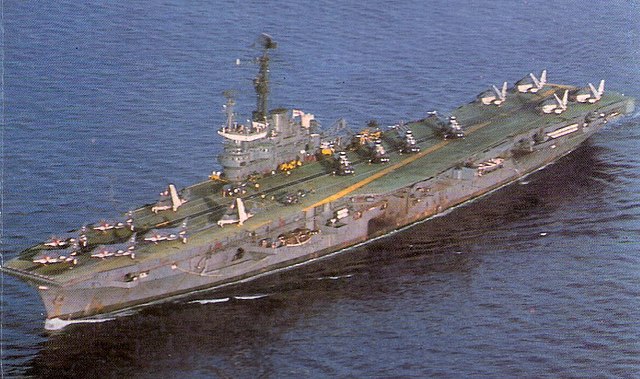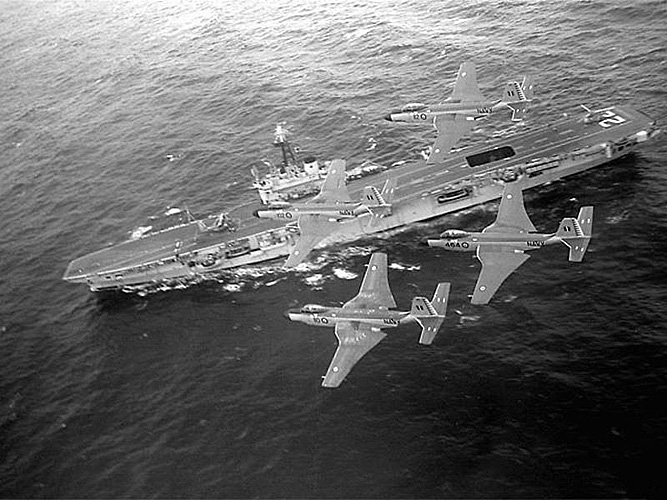 United Kingdom: 5 light fleet aircraft carriers:
United Kingdom: 5 light fleet aircraft carriers:HMS Majestic, Terrible, Powerful, Magnificient, Hercules, Powerful, 1 more cancelled (1944-1999) [wpcode id="44790"]
Of the Majestic class, apart HMS Leviathan which was cancelled, all five served postwar with the RCN, RAN, and Indian Navy, not with the Royal Navy.
A modified class
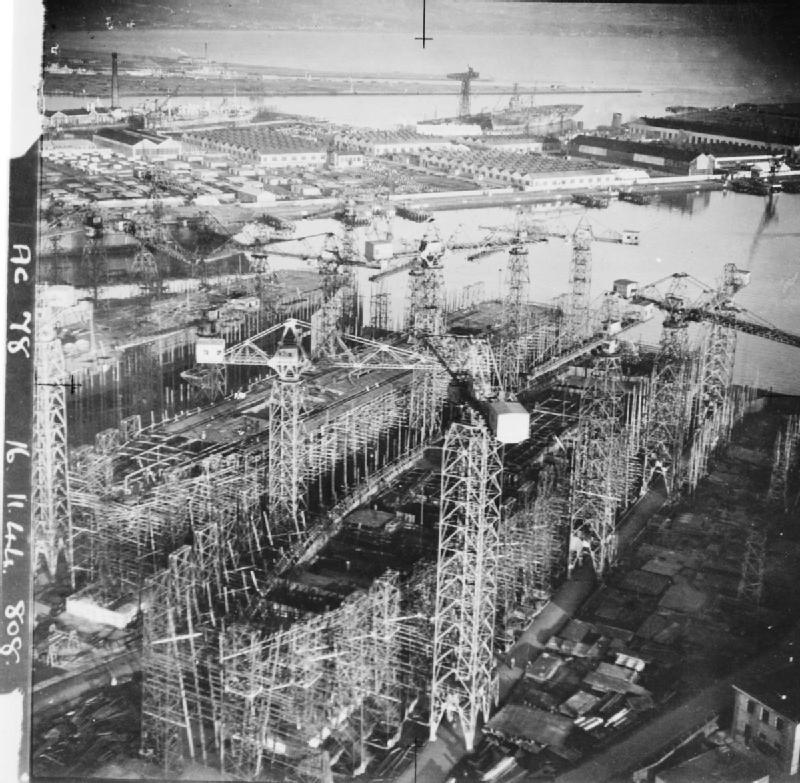
HMS Magnificient and Powerful in construction at Harland & Wolff, Belfast, November 1944.
The six remaining Light Fleet hulls were originally planned as standard Colossus-class ships, but carrier-based aviation grew up in size since 1942. Models such as the lend-lease Tarpon (Grumman Avenger), Corsair and Hellcat enlisted in the British Pacific Fleet were much heavier than the models that existed. The growing threat of Kamikaze later also advocated for strenghtinign the AA armament quite radically as a matter of survival. The aviation upgrade also went naturallt wit the adoption of better catapults, stronger arrestor cables, reinforced aircraft lifts, all to handle heavier and faster landing aircraft which went with reinforcing the flight deck (which also increased its resistance to ordnance).
Better AA armament and sensors
Anti-aircraft weapons also were somewhat badly placed or optimized and required modifications as well compared to the original design. As technology advanced in sensors too, new improved radars and fire control systems were to be fitted, requiring in turn more electrical power, so better generators, and reworked electrical network, reinforced masts and roofs, etc.Resplenishment at sea and more fuel
Also, both allies started to develop further resplenishment at sea, which in 1944 mattered more as these new shups would like serve with the BPF, in the vast expanses of the Pacific. Equipment to perform those replenishment at sea operations (RAS) were installed. They included an upper fuel line manageable by the crew underway, a line-firing cannon to bring out the fuel lines, new communication and safety systems. In the end all these modifications added 1,500 tonnes to the full-load displacement while the draught dove to by 1 foot 6 inches (0.46 m). With that many differences, the admirakty for the sake of calority reclassified them as the "Majestic class" accoridng to the lead ship, in September 1945. Five of these were launched before the end of the Second World War, the sixth in late September 1945 was however ultimately cancelled and scrapped. As the war ended for the others as well, completion work was suspended, and the admiralty started to discuss with the cash-stripped new government about their fate.Replanned construction and fate
Past September 1945, all work cease. Not only on HMS Majestic, but also on her sisters. They were given low-priority status, as a wartime emergency program mostly justified by tthe BPDF operations in the far east. Now all these plans were shattered and the RN had no use for them anymore. What was needed was a new generation of jet-carrting ships, much larger. There were already fleet carrier hulls available for transformation already, so they had all priority.Soon the qustion arose of what do do with all these hulls, not only those completed jus before the war ended, but never entering service in time (all but the first four Colossus class) and the unfinished (with still a lot of work to do) Majestic class. To be precise, Majestic was launched on 28 February 1945, Terrible on 30 September 1944, Magnificent on 16 November 1944, Hercules on 22 September 1945, Leviathan on 7 June 1945 and Powerful on 27 February 1945. HMS Terrible appeared the closest to completion at the time and the government had scruples to see these already paid ships by taxpayer money, scrapped altogether. The Navy on its side, not only lost manpower due to demobilization but had no use for them, not wanted to commit crews and finances to maintain these.
The best choice by then for the government for these unwanted ships was foreign purchases, at prices that would make them attractive. And so started the great "summer sales" of 1946-48. Right off the bat, some 16 ships (even the already serviced Colossus class) were now offered to foreign navies. The price was below the initial construction cost to be sure to sell them while recouping part of taxpayer's expenditures, and that was the occasion for these to get their hand on the first aircraft carrier of their history. Thus started the strange fate of these emergency ships planned for a war they never met, inadapted to modern jets, and yet that saw service with France, the Netherlands, Canada, Australia, Brazil, Argentina, and India... seeing plenty of action for some, like Arromanches in Indochina-Algeria or Vikrant with Pakistan, VC.de Mayo against the RN in the Falklands. While the Dutch, Canadian and Australian ships stand guard against the new threat of Soviet subs in the cold war.
Right off the bat, both Canada and Austrlia planned to acquired a ship each. But as the RN now said that she was willing to supervise upgrades in the concerned yards, and work opportunities returned, the yards were soon full. Two of the new class, HMS Magnificent and Terrible, entered service almost as designed, the first commissioned on 21 March 1948 and the second on 16 December the same year. Both would see service not under the RN flag, but with the RCN and RAN, respectively. In both cases they were merely seen as "stopgaps" before new upgaded carriers replaced them.
The next three ships were indeed heavily upgraded, reusing the experience gained already in modernizing other fleet carriers, sporting soon the trilogy of measures allowing them to operate early jets: Angled flight deck, steam catapult, and mirror landing aid. The sixth ships of the class, and less advanced was HMS Leviathan, and she was never completed. Work was suspended in May 1946, plans to convert her into a "commando carrier" or even a missile cruiser petered out due to the conversion cost, and prspects of sell fell through due to the remaining amount asked by the Yard to complete her. It should be also added that the list of potentuial customers for an aircraft carrier after the war was not large.
Thus, HMS Leviathan was never commissioned, and instead, her infinished hull was made at least waterproof and used as an accommodation ship in Portsmouth. In 1966, her boilers were removed, sold to the shipyard in charge of refitting the Colossus-class HNLMS Karel Doorman, for Argentine service as 21 de Mayo. Leviathan was ultimately scrapped in May 1968 and since all remaining ships found a customer, none ever saw service in the Royal Navy.
Design of the class (in brief)
The new carriers were very close to the originals, so no need to get into details about them. Better check the Colossus class for more. In 1943, eight 'Improved Majestics' were planned, but new developments and rapid obsolescence of the Light Fleet carrier concept, new wartime need for armoured carriers advocated for a complete rework of the design, which became a third class, arguably completely different from the 1942 fleet carrier program: The four Centaur class, next on naval encyclopedia.Hull and powerplant
Displacement standard, was 14,000 tonnes, and full, 17,780 tonnes. They measured 192 m pp (630 ft) and 211.8m (695 ft) overall, for a 24.4m (80 ft) beam and a draught of 7.01 m (23 ft) deep load.They were propelled by two shafts, three bladed screws, driven by two sets of Parsons geared steam turbines in turn fed by steam generated in four Admiralty 3-drum boilers for a total of 40,000 shp, enough for a top speed of 25 knots, which was less than armoured fleet carriers. No big changes so far compared to the Colossus. They carried 3,000 tons of fuel oil, enough for an endurance of 12,000 nautical miles at 14 knots. Crew comprised 1,300 men total. Dependong on the modififications of the ships sold, this varied in time.
Armament, sensors and planned air group
Initially they were equipped with nineteen 40mm/60 Mk III Bofors in single mounts and six quad 40mm/39 Mk VII Vickers "pom-pom". They also carried the type 79B, type 281B radars and type 144 sonar as planned. The air park also planned comprised 37 aircraft, upgraded to the Supermarine Seafire, Fairey Firefly, De Havilland Sea Hornet, Hawker Sea Fury, and Fairey Firebrand torpedo bombers. Again, this changed consiferably for each ships after being sold to foreign navies. To serve this air group they had a 5,131m², 210.3 x 24.4m flight deck and 2,142m²/11,355m³ 135.6 x 15.8 x 5.3m hangar. There were two centerline reinforced lifts of 16.5 x 10.4m weighting 6.8t each. The catapult BH-III was capable to launch a 6.4t plane at 122 km/h). Aircraft fuel stowage was 341,000 liters.
HCMS Magnificient in 1953. src navypedia
⚙ specifications | |
| Displacement | 14,000t standard, 17,780 t FL |
| Dimensions | 695 ft oa x 80 ft x 24 ft full load |
| Propulsion | 2x ¨Parsons GST, 4 Admiralty 3-d Boilers 40,000 shp |
| Speed | 25 knots (46 km/h; 29 mph) |
| Range | 12,000 nautical miles (22,000 km; 14,000 mi) at 14 knots |
| Armament | 19x 40mm/60, 6x4 40mm/39, see notes |
| Protection | As Colossus class |
| Crew | 1050 to 1500 |
Read More/Src
Books
Bastock, John (1975). Australia's Ships of War. Cremorne, NSW: Angus and Robertson.Bishop, Chris; Chant, Christopher (2004). Aircraft carriers: the world's greatest naval vessels and their aircraft. MI: Zenith.
Blackman, Raymond, ed. (1968). Jane's Fighting Ships, 1968–69 (71st ed.). London: Jane's Publishing Company.
Donohue, Hector (October 1996). From Empire Defence to the Long Haul: post-war defence policy and its impact on naval force structure planning 1945–1955. Papers in Australian Maritime Affairs (No. 1). Canberra: Sea Power Centre.
Hall, Timothy (1982). HMAS Melbourne. North Sydney, NSW: George Allen & Unwin.
Harding, Richard (2005). The Royal Navy 1930–2000: innovation and defence. Routledge.
Hobbs, David (1996). Aircraft Carriers of the British and Commonwealth Navies. London: Greenhill Books.
Hobbs, David (2005). "HMAS Sydney (III): a symbol of Australia's growing maritime capability". Crows Nest, NSW: Allen & Unwin.
Ireland, Bernard (2008) [2005]. The Illustrated Guide to Aircraft Carriers of the World. London: Anness Publishing.
Konstam, Angus (2010). British Aircraft Carriers 1939–45. New Vanguard No. 168. illustrated by Tony Bryan. Oxford: Osprey Publishing.
McCaffrie, Jack (2007). "Korea: The first challenge for Australian naval aviation". Stevens, David; Reeve, John (eds.). Sea Power ashore and in the air.
Polmar, Norman (2001) [1993]. The Naval Institute Guide to the Ships and Aircraft of the U.S. Fleet (17th ed.).
Preston, Anthony (2000). Aircraft Carriers. Sydney, NSW: AP Publishing.
Robbins, Guy (2001). The Aircraft Carrier Story: 1908–1945. London: Cassel & Co.
Snowie, J. Allan (1987). The Bonnie: HMCS Bonaventure. Erin, ON: The Boston Mills Press.
Wragg, David (2009). A Century of Maritime Aviation: 1909–2009. South Yorkshire: Pen & Sword Maritime.
Wright, Anthony (June 1998) [1978]. Australian Carrier Decisions: the acquisition of HMA Ships Albatross, Sydney and Melbourne.
Links
battleships-cruisers.co.ukawm.gov.au
seaforces.org
nationalcoldwarexhibition.org
navypedia.org/
/1942_Design_Light_Fleet_Carrier
Videos
https://youtu.be/4DHDhBfd6Hg: Colossus/Majestic Class - Guide 141 https://youtu.be/tn5adGdk3X8: Colossus-class and Majestic-class, The aircraft carriers of many naviesModel Kits
On scalematesThe only one covered was HMAS Melbourne 1956 by Imperial Hobby Productions 1:700, leading to more scratchbuilt declinations like Vikrant and Bonaventure. A very large 1:72 is also made by Southern Cross Models
3D model on CG Trader
3D print versions 64.3 x 11 x 12.7mm
 HMS Majestic/HMAS Melbourne 1955-1982
HMS Majestic/HMAS Melbourne 1955-1982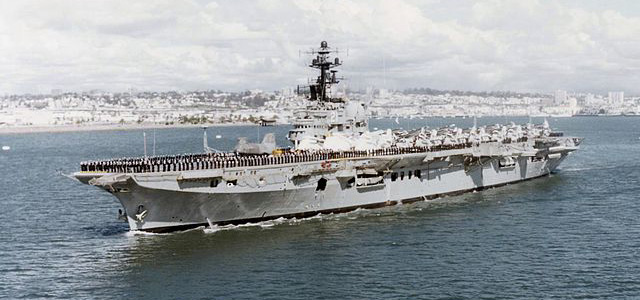
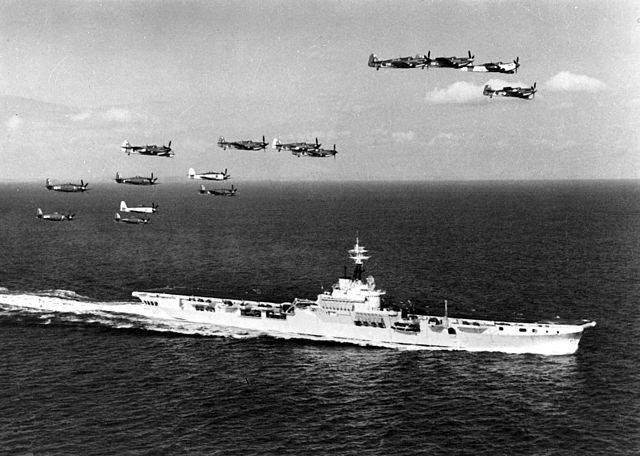
 HMS/HCMS Magnificent 1948-1957
HMS/HCMS Magnificent 1948-1957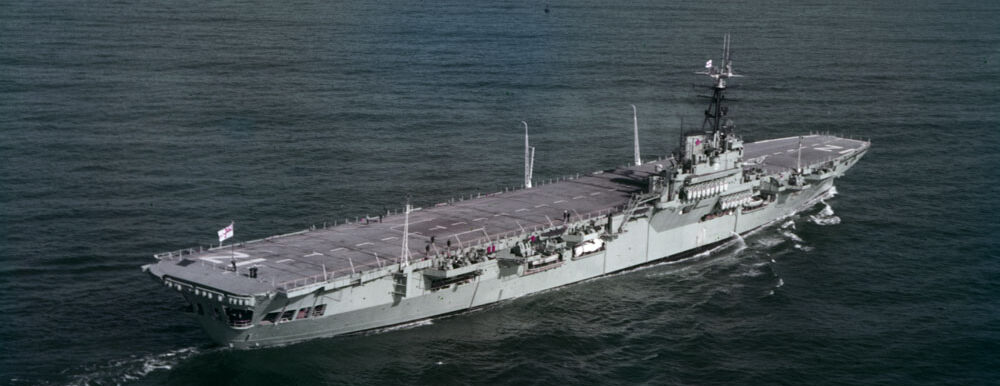
 HMS Hercules/RIN Vikrant 1961-1997
HMS Hercules/RIN Vikrant 1961-1997